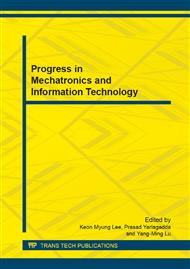[1]
LUXIMON A, GOONETILLEKE R, TSUI K. Foot landmarking for footwear customization [J]. Ergonomics, 2003, 46(4): 364-83.
DOI: 10.1080/0014013021000045225
Google Scholar
[2]
LI M J, GENG W D. The Extension of Geodesics [J]. Applied Mechanics and Materials, 2013, 333(95-104).
Google Scholar
[3]
MENGJIAN L, WEIDONG G. Shoe last girth measuring by an extended geodesic with width [J]. Journal of Computer-Aided Design & Computer Graphics, 2013, 25(10).
Google Scholar
[4]
N CHER B, ALEMANY S, GONZ LEZ J, et al. A footwear fit classification model based on anthropometric data; proceedings of the Proceedings of the 8th annual digital human modelling for design and engineering symposium: 4-6th July 2006 Lyon, F, 2006 [C].
Google Scholar
[5]
WITANA C P, FENG J, GOONETILLEKE R S. Dimensional differences for evaluating the quality of footwear fit [J]. Ergonomics, 2004, 47(12): 1301-17.
DOI: 10.1080/00140130410001712645
Google Scholar
[6]
KOS L, DUHOVNIK J. A System for Footwear Fitting Analysis; proceedings of the Proceedings of the 7th International Design Conference-DESIGN 2002, F, 2002 [C].
Google Scholar
[7]
XIAO M, YIFAN Z, LUXIMON A. A shoe-last selection system based on fit rating [J]. International Journal of Human Factors Modeling and Simulation, 2011, 2(4): 327-40.
DOI: 10.1504/ijhfms.2011.044979
Google Scholar
[8]
RUP REZ M J, MONSERRAT C, ALCA IZ M. Simulation of the deformation of materials in shoe uppers in gait. Force distribution using finite elements [J]. International Journal on Interactive Design and Manufacturing (IJIDeM), 2008, 2(2): 59-68.
DOI: 10.1007/s12008-008-0036-6
Google Scholar
[9]
RUP REZ M, GINER E, MONSERRAT C, et al. Simulation of the behavior of the calfskin used as shoe upper material in footwear CAD [J]. Computer-Aided Design, (2012).
DOI: 10.1016/j.cad.2012.06.009
Google Scholar
[10]
IRVING G, TERAN J, FEDKIW R. Invertible finite elements for robust simulation of large deformation; proceedings of the Proceedings of the 2004 ACM SIGGRAPH/Eurographics symposium on Computer animation, F, 2004 [C]. Eurographics Association.
DOI: 10.1145/1028523.1028541
Google Scholar
[11]
M LLER M, GROSS M. Interactive virtual materials; proceedings of the Proceedings of Graphics Interface 2004, F, 2004 [C]. Canadian Human-Computer Communications Society.
Google Scholar
[12]
MOLINO N, BRIDSON R, FEDKIW R. Tetrahedral mesh generation for deformable bodies; proceedings of the Proc Symposium on Computer Animation, F, 2003 [C].
Google Scholar
[13]
WANG C-S. An analysis and evaluation of fitness for shoe lasts and human feet [J]. Computers in Industry, 2010, 61(6): 532-40.
DOI: 10.1016/j.compind.2010.03.003
Google Scholar
[14]
BUADES J M, GONZ LEZ-HIDALGO M, PERALES F, et al. A Fast Geometric Deformation Method to Adapt a Foot to a Platform [M]/GONZ LEZ HIDALGO M, MIR TORRES A, VARONA G MEZ J. Deformation Models. Springer Netherlands. 2013: 121-43.
DOI: 10.1007/978-94-007-5446-1_5
Google Scholar
[15]
BARAFF D, WITKIN A. Large steps in cloth simulation [M]. Proceedings of the 25th annual conference on Computer graphics and interactive techniques. ACM. 1998: 43-54.
DOI: 10.1145/280814.280821
Google Scholar


